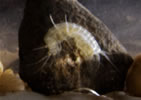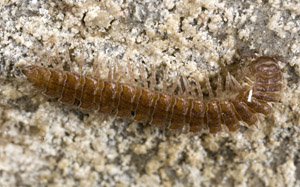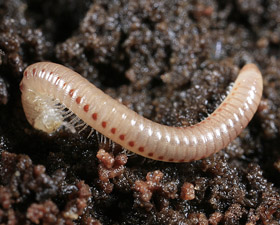SPIDERS
The Order Arachnida includes spiders (old English: spinnan means spinner), harvestmen, ticks, mites and scorpions. All have eight legs, are carnivorous possessing sharp fangs and most have venom (no UK ones are dangerous to humans though).
Meta menardi is a large, dark brown, orbweb spinning troglophilic cave spider that is well known to cavers. Meta spiders need space to create these webs, but they are not spun across the cave passage like normal orb spiders unless there is nothing else to anchor the web to. The threads of the web of Meta menardi are not sticky and appear to serve as a supportive platform for the spider rather than directly serving to trap prey, instead the radial threads act as a series of trip lines to detect the presence of potential prey on the cave walls and ceiling. When it has spun its web it eats the middle and straddles the hole. They feed on woodlice, millipedes, slugs, earthworms, flies (Culex pipiens in particular) and possibly smaller Meta menardi (although there is no evidence of this). It can gorge itself and may store food by trussing it in the web. It does not appear to be as common in the north of England compared to southern caving regions but has been seen in Sell Gill Holes, Scoska and High Douk Holes.
Meta menardi prefers reflected light and dim zones (not direct light) and appears to live slightly deeper in a cave during the winter. Movements of different species towards or away from the threshold at different times of year may change the dynamics of the spider’s diet. It also appears to prefer vertical shafts, presumably because more prey might fall in. The webs are orientated away from light – at 90 degrees and are to be found in the shadows e.g. in phreatic pockets and scallops – by spinning them here they may trap fungus gnats seeking shade or maybe they are simply harder for prey to spot.
The female lays a clump of eggs and spins a silk cocoon around them for protection. You may see these hanging from the ceiling. M. menardi is variable in colour but does not have spots on the legs like Metallina merianae.
Meta bourneti is very rare (there are no recordings in caves of the region) but this could be due to the fact that it looks very similar to Meta menardi and the observer is likely to assume it is the common M. menardi. To tell the difference you need to look at the male palps and the epigyne.
|
Meta menardi, Greater Kelcow cave. Note the absence of spots on the legs. |
Metellina merianae (formerly in the genus Meta) is found in the threshold, often at the entrance itself where it spins an orb web to catch creatures flying in and out of the cave. The webs are spun across the passage and so are more obvious. Outside the cave the webs are built at night to catch Nematocera gnats. It is a similar shape to Meta menardi, but is smaller, lighter brown with dark spots on the legs. It is generally found in the shallow threshold zone, whilst Meta menardi is often found deeper in the cave. The two species are frequently recorded from the same caves. Metellina merianae appears to be more common than Meta menardi in the northern caves.
|
Metellina merianae, Goyden Pot.
Note the spots on the legs. |
In cracks, pockets and small bedding planes in the cave threshold and into the dark zone you might see Nesticus cellanus. The spider does not spin an orb web, but is often hanging from a simple sheet web that is connected to the floor and walls with long threads– at the base of these threads are sticky droplets to catch crawling insects – in this way it avoids competing for the same food as Metellina merianae. The web is usually seen before the spider. Look on the side of the passage in eg 20cm bedding planes, or from cobbles in stream onto the wall, the vertical strands can be seen with a spider lurking at the top against the ceiling. This is quite a common spider deeper in the caves and can be seen in many caves in Chapel le Dale e.g. Sunset Hole and High Douk Holes.
|
Nesticus cellanus, Sunset Hole
It has dark stripes on the legs and a distinctive but variable pattern on the abdomen. |
There are a number of linyphiids or ‘money spiders’ found in caves (it is good luck if a spider crosses your path, though maybe not for the spider given many peoples attitude to spiders). P. convexum is commonly recorded in the northern caves (Browgill, Borrins Moor, Rowten). The adult is brown or orange, juveniles white. Porrhomma sp. webs are often in obscure cracks and crevices in the walls of the cave, and the spiders even harder to spot. Porrhommas build a sheet web and then hang underneath it.
Spiders may not have many predators in the caves - bats do not appear to be interested, except possibly Natterer's bat Myostis natterei in caves during cold weather or when hibernating.
Harvestmen (Opilionida) have been recorded from the threshold of caves including Mitopus morio. They are accidentals, their true habitat being the matted grasses and loose soils around the entrances. Harvestmen do not make webs and lack venom, they are scavengers on dead and also soft bodied invertebrates.
|
The harvestman Nemastoma bimaculatum in Goyden Pot |
Pseudoscorpions are small and abundant arthropods but are difficult to spot as they are only 2-4mm in length. They are aggressive hunters and use their enlarged pedipalps to catch prey such as mites and larvae. Once it has sucked up the contents of its prey it can survive for weeks even months without another meal.
MITES are small relatives of spiders. Some mites are truly microscopic and go unnoticed. They live in a variety of habitats - some free-living, some parasitic on plants and animals, others preying on Collembola and other small insects.
There are a number of mites found living in the northern caves, including members of the genera Eugamasus and Rhagidia, as well as a variety of other genera and species. Rhagidia mites run about quickly with no apparent purpose except possibly to hide from your light. Many of the records are thought to be of accidentals (possibly blown into caves or brought in on the mud on cavers’ boots) but some may be regarded as troglophiles (e.g. Veigaia transisalae and some members of the Eugamasus magnus group) and possibly even troglobites (e.g. Rhagidia spelaea) in Britain. The latter is recorded in Gaping Ghyll and Stump Cross Caverns.
|
Troglomorphic mite Rhagidiidae, Goyden Pot |
Water mites (Hydracarina) are another group that have been little studied.
Parasitic ticks and mites in caves are associated with bats.
There are no records of these in the northern caves, but they must exist.
MILLIPEDES and other MYRIAPODA
The Pauropoda ‘small feet’ are tiny (1mm), blind creatures similar in shape to centipedes with 9-11 pairs of legs that are generally found in soil feeding on dead plant matter. They look a bit like springtails but if you blow on them they run quickly backwards. They are thought to be scavengers.
Although there are no records from northern caves there are cave records from elsewhere in the country and they might be found in accumulations of detritus in the threshold zone.
The Symphyla are slightly larger (still under 1cm) blind, white centipede-like organisms that also live on dead plant matter in soil. Juveniles have six pairs of legs, but over a lifetime of several years they add an additional pair at each moult, so that the adult instar has twelve pairs of legs. Symphylella isabellae has been found in Furness mines, and is sometimes found far into the dark zone.
Millipedes (Diplopoda – ‘twin feet’ have two legs per segment). Millipedes date back to over 425 millon years ago, making them the oldest terrestrial animals. Their ancestors were remarkably similar to those seem today. They are adapted for pushing their way through soil and leaf litter as they feed on decaying plant matter including wood. Millipedes are docile creatures and often curl up if they feel threatened, but also have passive defence mechanisms including caustic and noxious chemicals. Some release cyanide, which smells a bit like bitter almonds. Their eggs hatch into a 6 legged first stadium which can be confused for an insect. It moults a number of times, gaining segments and legs each time until it becomes the adult. Some species die after mating and therefore only live for one year, whilst other species may live for five years. The short life cycle of some species means that at certain times of year it is difficult to find adults. Cave forms often have a thinner shell and more sensory bristles than those on the surface. Millipedes are one of the larger creatures in the cave ecosystem and include a number of cavernicolous species, many of which are blind.
The Order Polydesmida (the flat backed millipedes) get their name from the broad extensions to the body armour giving them a flattened appearance. They include Nanogona, Polydesmus, Brachydesmus, and Oxidus and have distinctive flattened bodies with about 20 segments, grow to 20-40 mm long and vary in colour from whitish to brown. Some of these species produce hydrogen cyanide.
The Eyed Flat-Backed millipede Nanogona polydesmoides (=Polymicrodon polydesmoides) is a common, caverniculous species and widely distributed in Britain. It is paler than Polydesmus angustus, light brown in colour with distinct rounded lobes at the edges of its plates, and has ocelli (eyes). It has been recorded from a number of northern caves including Goyden Pot, Ingleborough Cave and the caves around Morecambe Bay. Although common in Britain it is much scarcer on the continent.
The Common Flat Backed millipede Polydesmus angustus is widely distributed in Britain. The bodies of the blind adults are 14 to 25 millimeters in length flat, brown, with 20 segments. The plate segments covering the back are ridged along their lengths (they are more angular than N. polydesmoides). The antennae and legs are longer than in most other millipedes. As a defence mechanism they can secrete almond smelling fluids (cyanide) to repel predators. It has been recorded in Borrins Moor Cave, and in the caves around Morecambe Bay.
Brachydesmus superus is small (8-10mm), blind, pale (light brown/off white) with 19 segments, and has been recorded in County Pot. It is considered caverniculous. On the surface most records of adults are from March to June with few records of adults during August and September. This suggests it has an annual life cycle and dies after breeding in summer, although a few early maturing adults may overwinter.
|
Common Flat Backed millipede Polydesmus angustus, Scoska Cave |
Another common caverniculous species is the blind Spotted Snake Millipede Blaniulus guttulatus. The red spots down the sides are stink glands (ozadenes). This millipede may be more common in caves during winter when the colder temperatures encourage the millipede to go deeper into the soil.
|
Spotted Snake Millipede Blaniulus guttulatus, Ibbeth Peril |
The very rare millipede Cylindroiulus parisiorum has been recorded in Borrins Moor Cave. In the UK its distribution appears to centre on the Cotswolds.
Centipedes are normally regarded as soil organisms and there have been few recordings from caves. They are active predators with poison claws feeding on nematodes, mites and other smaller insects. The most common species that might be encountered is Lithobius microps (=L. dubosqui), a small (to 10mm), robust, red-brown, rather short-bodied species with 15 pairs of legs. Immature ones can be hard to identify as features are added as they grow such as antennae segments, teeth etc. It might be regarded as a possible cavernicole although unlike some other centipedes and many of the millipedes found underground this species has ocelli (simple eyes).
When disturbed it may curl up like a millipede.
After each moult centipedes may have a violet tinge for a few hours. |


.jpg)
.jpg)
.jpg)
.jpg)
.jpg)

